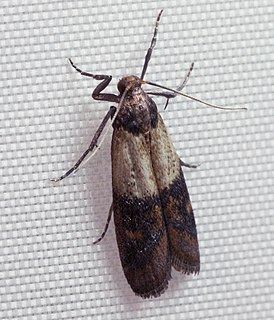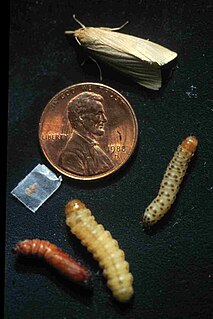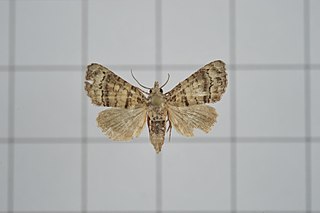
Bookworm is a general name for any insect that is said to bore through books.

The Crambidae are the grass moth family of lepidopterans. They are variable in appearance, the nominal subfamily Crambinae taking up closely folded postures on grass stems where they are inconspicuous, while other subfamilies include brightly coloured and patterned insects which rest in wing-spread attitudes.

Saturniidae, commonly known as saturniids, is a family of Lepidoptera with an estimated 2,300 described species. The family contains some of the largest species of moths in the world. Notable members include the emperor moths, royal moths, and giant silk moths.

The codling moth is a member of the Lepidopteran family Tortricidae. They are major pests to agricultural crops, mainly fruits such as apples and pears. Because the larvae are not able to feed on leaves, they are highly dependent on fruits as a food source and thus have a significant impact on crops. The caterpillars bore into fruit and stop it from growing, which leads to premature ripening. Various means of control, including chemical, biological, and preventive, have been implemented. This moth has a widespread distribution, being found on six continents. Adaptive behavior such as diapause and multiple generations per breeding season have allowed this moth to persist even during years of bad climatic conditions.

The Indianmeal moth, also spelled Indian meal moth and Indian-meal moth, is a pyraloid moth of the family Pyralidae. Alternative common names are weevil moth, pantry moth, flour moth or grain moth. The almond moth and the raisin moth are commonly confused with the Indian-meal moth due to similar food sources and appearance. The species was named for feeding on Indian meal or cornmeal, and does not occur natively in India. It is also not to be confused with the Mediterranean flour moth, another common pest of stored grains.

The European corn borer, also known as the European corn worm or European high-flyer, is a moth of the family Crambidae which includes other grass moths. It is a pest of grain, particularly corn. The insect is native to Europe, originally infesting varieties of millet, including broom corn. The European corn borer was first reported in North America in 1917 in Massachusetts, but was probably introduced from Europe several years earlier. Since its initial discovery in the Americas, the insect has spread into Canada and westward across the United States to the Rocky Mountains.

Hyblaea puera, the teak defoliator, is a moth and cryptic species complex native to South Asia and South-east Asia. It was first described by Pieter Cramer in 1777. The species has also been recently reported to be present in Central America and Africa. The caterpillar feeds on teak and other trees. It is considered to be one of the major teak pests around the world.
Home-stored product entomology is the study of insects which infest foodstuffs stored in the home. It deals with the prevention, detection and eradication of the pests. The five major categories of insects considered in this article are flour beetles, the drugstore beetle, the sawtoothed grain beetle, the Indianmeal moth and fruit flies.

Brithys crini, the amaryllis borer, crinum borer, lily borer or Kew arches, is a moth of the family Noctuidae. It is a garden pest in parts of its range, as their larvae damage the stems and leaves of lilies, especially lilies of the family Amaryllidaceae.

Gynaephora groenlandica, the Arctic woolly bear moth, is an erebid moth native to the High Arctic in the Canadian archipelago, Greenland and Wrangel Island in Russia. It is known for its slow rate of development, as its full caterpillar life cycle may extend up to 7 years, with moulting occurring each spring. This species remains in a larval state for the vast majority of its life. Rare among Lepidoptera, it undergoes an annual period of diapause that lasts for much of the calendar year, as G. groenlandica is subject to some of the longest, most extreme winters on Earth. In this dormant state, it can withstand temperatures as low as −70 °C. The Arctic woolly bear moth also exhibits basking behavior, which aids in temperature regulation and digestion and affects both metabolism and oxygen consumption. Females generally do not fly, while males usually do.

The southwestern corn borer, Diatraea grandiosella, is a moth belonging to the sub-order Heterocera. Like most moths, The southwestern corn borer undergoes complete metamorphosis developing as an egg, larva (caterpillar), pupa and adult. It is capable of entering diapause in its larva stage and under the conditions of a precise photoperiod. Growth and development are regulated by juvenile hormones. The southwestern corn borer has an extensive range. It occurs in Mexico and in Alabama, Arizona, Arkansas, Colorado, Illinois, Indiana, Kansas, Kentucky, Louisiana, Mississippi, Missouri, Nebraska, New Mexico, Oklahoma, Tennessee, and Texas.

Omphisa anastomosalis, the sweetpotato vineborer, is a moth of the family Crambidae. It is widespread, with records including the Philippines, Indonesia, New Guinea, India, Sri Lanka, Malaysia, Taiwan, Hawaii, Vietnam, China, Japan, Cambodia, Laos, Burma and Thailand.

Penicillaria jocosatrix, the mango shoot borer, is a moth of the family Noctuidae first described by Achille Guenée in 1852. It is found from southeast Asia to the Pacific. Records include Borneo, Guam, Hawaii, India, Sri Lanka, Thailand and in Australia, Western Australia, the Northern Territory and Queensland.

Cadra figulilella, the raisin moth, is a moth of the family Pyralidae. The raisin moth is known most commonly as a pest that feeds on dried fruits, such as the raisin and date. It covers a range that includes much of the world, primarily situating itself in areas of California, Florida, the Eastern Mediterranean region, and some parts of Africa, Australia, and South America. The moth prefers to live in a hot, arid climate with little moisture and plentiful harvest for its larvae to feed on. Study of this species is important due to the vast amount of economic damage it causes yearly and worldwide to agriculture crops.

Busseola fusca is a species of moth that is also known as the maize stalk borer. It is known from Ethiopia.
Bamboo borer may refer to:
Chilo partellus, the spotted stalk borer or spotted stem borer, is a moth in the family Crambidae. It was described by Charles Swinhoe in 1885. It is found in India, Pakistan, Ethiopia, Lesotho, Madagascar, Malawi, South Africa, Sudan, Tanzania, Uganda and on Mayotte.

Maguey worms, are one of two species of edible caterpillars that infest maguey and Agave tequilana plants.

Chlumetia transversa, the mango shoot borer, is a moth of the family Euteliidae. The species was first described by Francis Walker in 1863. It is a widely distributed across Indo-Australian tropical countries far east to Solomon Islands.

Mudaria luteileprosa, or the Durian seed borer is a species of moth in the family Noctuidae. It is found in Malaysia, Indonesia, and Thailand.


















